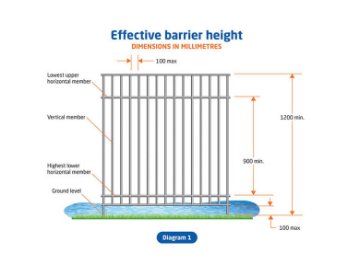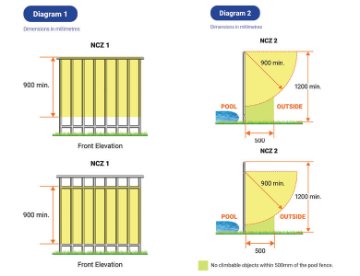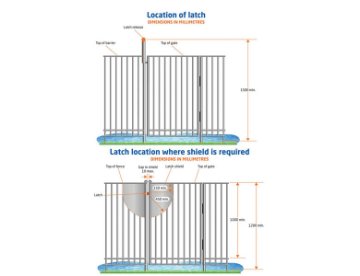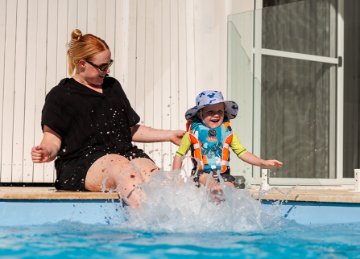- Scrolling to Is your pool or spa safe?
- Scrolling to Book a pool/spa inspection
- Scrolling to Design and construction elements
- Scrolling to Fencing height, perforate materials and ground clearance
- Scrolling to Types of materials, indentations and projections
- Scrolling to Boundary barrier (dividing fences), above ground pools or spas
- Scrolling to Horizontal surfaces (including rods/braces/hinges)
- Scrolling to Latching devices
Make sure your pool or spa meets all safety requirements. Understand essential safety tips, maintenance advice and pool/spa inspection requirements to help protect your family and community.
Is your pool or spa safe?
Make sure your pool or spa is ready for summer:
- Ensure your pool or spa has a compliant safety barrier
- Regularly check that your gates self-close and self-latch, and are in good condition. Carry out repairs immediately
- Keep safety barriers clear of climbable objects and never prop open a pool or spa gate
- Always supervise children around water and keep a clear line of sight
- Learn CPR and first aid, and teach children water safety
- Use a hard cover when your spa is not in use
- Regularly check and maintain pool water quality
- Store pool chemicals in a cool, dry place, out of reach of children and pets.
Pool and spa inspections
The State Government has introduced mandatory requirements for pool and spa inspections.
- Initial inspection: New swimming pool or spa barriers must be inspected within 30 days of completion
- Reinspection: Non-compliant barriers must be reinspected within a maximum of 60 days of the previous inspection
- Regular inspections: Safety barriers must be inspected at least once every four years. The inspection fee is incorporated in your annual rates notice.
Design and construction elements

Fencing height, perforate materials and ground clearance
- The fence and its immediate surrounds are to be designed to form an effective barrier against child access at any point. Fencing must be a permanent structure, unable to be removed or undone by hand or key at any point. Fencing must be free of sharp edges, sharp projections and similar hazards
- Openings that are 13mm or less are deemed unclimbable. If the opening is greater than 13mm but less than 100mm, the fence must be at least 1800mm in height
- The space between the finished ground level and the lowest horizontal member of the fencing shall not exceed 100mm and the ground must be stable.

Types of materials, indentations and projections
- Fencing may be constructed of any material, provided it is durable and complies with the Australian Standard 1926.1.-2012. If the material used for the construction of the fence is suspected to be non-compliant the City may request a copy of a test report confirming its suitability.
- Any indentation, projection or gap greater than 10mm may be considered climbable. A wedge or fillet of at least 60 degrees to the horizontal can be fitted to most projections to render it unable to climb, although it must be flush with the wall/fence behind.
_780x600_jpg_360_276.webp)
Boundary barrier (dividing fences), above ground pools or spas
If a dividing fence or front fence forms part of the barrier, it must:
- Be at least 1800mm in height on the inside of the barrier
- Have 900mm non-climbable zone, measured from the top of the fence, on the inside of the barrier
- Alternatively use the non-pool side of a boundary barrier where it is at least 1200mm in height and complies with NCZ 1, 2, 3, and 4 (see diagram 15).
The walls of the pool or spa can be used as the barrier if they are not less than 1200mm in height and have no climbable projections or indentations. A fence and gate that complies with the Australian Standard 1926.1-2012 must be fitted around the designated access point to the above ground pool or spa.

Horizontal surfaces (including rods/braces/hinges)
Horizontal surfaces (including rods/ braces/hinges) Unless gaps between the verticals are 10mm or less, and horizontal rails of the fence are inaccessible or on the inside of the fence, the horizontal surfaces must be at least 900mm apart. There must be a 900mm non-climbable zone anywhere within the vertical height of the barrier.
Spacing between uprights must not exceed 100mm. Vertical members must be strong and rigid with very little flexibility.

Latching devices
Latching device - gates must be fitted with a self-latching device that will automatically operate on the closing of the gate and will prevent the gate from being re-opened without manually releasing the mechanism. The gate latch must not be able to be opened by the insertion of an implement particularly from underneath the latch. The gate latch must not be capable of being unlatched with the use of manual force (usually downwards) to the gate.
Location of latching device - gate latches must be located at least 1500mm high from the finished ground level and 1000mm above the highest lower horizontal member OR located on the inside of the gate. If located on the inside of the gate, the latch must be located at least 150mm below the top of the gate and shielded so no opening greater than 10mm occurs between the top of the gate and a radius of 450mm from the latch and below the latch. Any hand-hole to the latch must be at least 1200mm above the ground and 150mm above the latch release.
For further information about swimming pool and spa barriers, please visit the Department of Energy, Mines, Industry Regulation and Safety.


